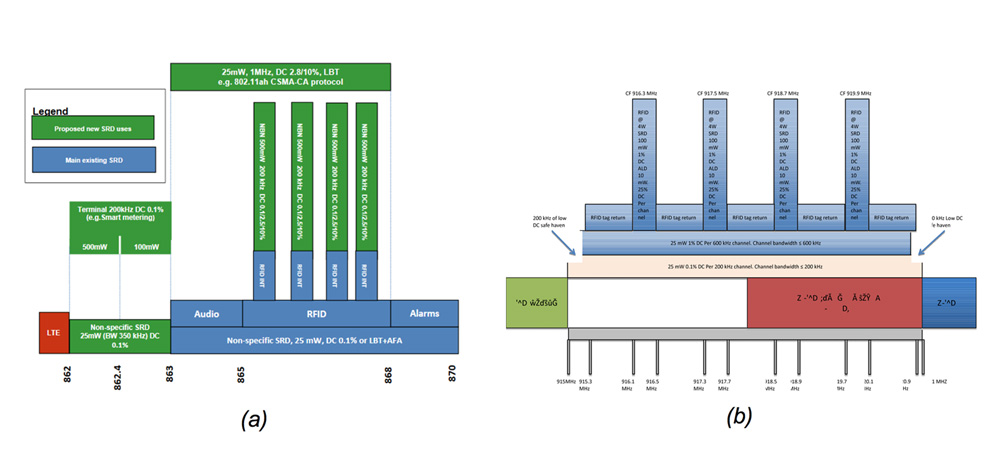ECC Newsletter December 2017
Providing spectrum to support machine-to-machine communications
As home automation, smart energy, industrial applications and intelligent transport become a reality, machine-to-machine (M2M) communications technologies are increasingly prevalent. M2M — also referred to as 'machine type communications (MTC)' and the 'Internet of Things (IoT)'— present opportunities in new market sectors such as remote healthcare, smart cities and agriculture. But in order, for these exciting new applications to work, there must be connectivity to a widespread deployment of a large number of devices. Therefore, these new applications bring new demand for spectrum.
Figure 1: Examples of some M2M deployment scenarios
In a special edition of the ECC newsletter in April 2016, we reported on the outcome of a CEPT workshop to determine spectrum, numbering and harmonisation needs for M2M1. From a spectrum point of view, one of the key elements is that, due to their diversity, M2M communications are expected to make extensive use of a range of different radio applications/systems. These include: private mobile radio systems (PMR); public access mobile radio systems (PAMR); mobile networks; short range devices (SRD); radio local area networks (RLANs), as well as satellite systems. The workshop identified in particular a need for dedicated spectrum for utilities in the 400 MHz range (410-430 MHz and 450-470 MHz), and improved harmonisation in the 900 MHz range (862-876 MHz and 915-921 MHz). The possibility for commercial mobile networks to address M2M needs was also identified.
Shared spectrum access — especially in the 400 MHz bands, as well as frequency bands used by short range devices — was proposed, to allow new technologies to use existing spectrum in an opportunistic way. This is partly based on the assumption that while some networked M2M applications can reach very high device usage densities (e.g. 50,000 devices/km2) , in particular in metropolitan areas, individual devices only use the spectrum for a very small fraction of the time.
So, what are the recent developments in these and other areas?
Harmonisation of dedicated spectrum for M2M
The current European regulatory framework applicable to SRD is specified in ERC Recommendation 70-03 for CEPT and in the EC Decision 2017/1483/EU for EU member states. It already allows the possibility to roll out M2M systems in various harmonised bands for SRD, provided they fulfil the relevant technical parameters. In particular, bands identified for the category "non-specific short-range devices" are the most favourable for new innovative M2M usages, including wide-area networks in 169.4-169.475 MHz, 865-868 MHz (limited to the four RFID channels), 868.0-868.6 MHz and 869.4-869.65 MHz.
Furthermore, as reported in our July 2016 edition, additional opportunities have been identified in the frequency bands 870-876 MHz and 915-921 MHz, which are suitable in particular for new types of M2M applications in SRD networks. The conditions currently defined in ERC Recommendation 70-03 allow for a soft harmonisation approach, where the spectrum availability and the national usage may vary in different portions of these bands, taking into account the existing and planned use of these bands by other applications/services.
In its work under a permanent mandate from the EC to regularly review spectrum harmonisation for SRD, ECC published in early 2017 an Addendum to CEPT Report 59. It specifically addressed the possibilities for further harmonisation of the 862-876 MHz and 915-921 MHz frequency bands for SRD.
While the EC included recommendations from ECC for the band 863-868 MHz in its recent update of the EC Decision for SRD, discussions on an EU-harmonised approach for the 870-876 and 915-921 MHz bands are ongoing.
Figure 2: Spectrum use overview in the 'SRD domain': (a) 862-870 MHz and (b) 915-921 MHz
M2M in dedicated land mobile networks
There is no "one solution fits all" approach for M2M connectivity. In the smart energy sector, while a low voltage smart grid could make use of licence-exempt SRD spectrum, high voltage smart grids will require enhanced communications and extremely resilient systems. Customised dedicated systems in licensed spectrum are needed since other solutions cannot fulfil requirements such as low latency and high availablity.
Similarly, the transportation and government sectors may also require dedicated M2M network solutions.
In this context, ECC has undertaken studies to expand the opportunities for M2M using professional private mobile radio (PMR) or public access moble radio (PAMR) networks. As a result, Project Team FM54 is continuing to review the CEPT framework applicable to PMR/PAMR. This includes a revision of the CEPT Recommendation T/R 25-08, which describes planning criteria and coordination of frequencies for land mobile systems in the range 29.7-470 MHz. It also comprises the development of a new technology-neutral ECC Decision, which is intended to make available, in response to market demand, a sufficient amount of spectrum for land mobile systems within a set of frequency ranges between 68 and 470 MHz 2.
One of the main focuses of this work is to facilitate narrowband, wideband and broadband solutions (including mobile technology) within the 410-430 MHz and 450-470 MHz bands. It is supported by an extensive package of compatibility studies, which are nearing completion within Project Team SE7. These studies address the coexistence of these various solutions for PMR/PAMR and also the compatibility with a range of applications within and in adjacent bands, including Digital Terrestrial Television (DTT), radars, radio astronomy, fixed service, as well as several others.
Opportunities for mobile cellular networks to support M2M
The possibility of deploying M2M within commercial mobile networks was studied in ECC Report 266. The analysis focussed on a number of bands currently identified for mobile cellular networks within CEPT, i.e. 700 MHz, 800 MHz, 900 MHz, 1800 MHz, 2.1 GHz and 2.6 GHz.
The analysis in this report was based on various cellular M2M technologies developed within 3GPP, which allow M2M to be incorporated within an existing cellular network in different ways:
- Extended Coverage GSM IoT (EC-GSM-IoT): This is an evolution of the existing GSM air interface with a channel bandwidth of 200 kHz. The analysis concluded that it can be implemented in the 900 and 1800 MHz bands, as it is similar to existing GSM
- LTE Machine Type Communication (LTE-MTC) and evolved MTC (LTE-eMTC)3: LTE-based technology where M2M is integrated in a normal LTE carrier. The Report concluded that, as an integral part of the system, LTE-MTC/eMTC can be deployed in any of the considered frequency bands.
- Narrowband IoT (NB-IoT)4: LTE-based technology where a dedicated 200 kHz independent carrier is used either 'standalone' (i.e. independently in its own spectrum), 'in-band' within an existing LTE carrier, or in the guard band adjacent to an existing carrier. The Report describes the conditions under which NB-IoT can be deployed in the considered bands.
Figure 3: Overview of LTE M2M options within a mobile operator's spectrum block: (a) LTE-eMTC; (b) In-band NB-IoT; (c) Guard band NB-IoT
As a follow-up activity, a revision of ECC Decision(06)13, which sets the regulatory framework for the 900 MHz and 1800 MHz bands, is currently underway to include M2M cellular technologies. For the other bands, the technology-neutral technical conditions set up in the relevant ECC Decisions already provide the opportunity for M2M operation — under the condition that compliance to the relevant Block-Edge Mask (BEM) is met.
Satellite connectivity for M2M
In order to achieve widespread coverage for M2M communications, satellite systems may provide appropriate solutions, in particular in remote areas with no or poor terrestrial coverage. In this context, Project Team FM44 is currently studying the feasibility of M2M operation through satellites, from both a technical and regulatory point of view. This study will explore technical opportunities and suitable frequency bands for the introduction of M2M applications via satellite, in order to extend terrestrial networks and create complementary services. Work on the study is expected to be finalised in the second half of 2018.
The future for M2M spectrum in Europe and beyond
In this article we have summarised a set of complementary activities that aim to identify appropriate solutions around spectrum for M2M communications in Europe. These initiatives contribute to the spectrum roadmap for IoT as defined by the Radio Spectrum Policy Group (RSPG) in November 2016.
Considerations on spectrum for M2M are not limited to Europe. Spectrum for M2M at a global level, both in dedicated bands and within mobile bands, is also being studied within the ITU-R. It is specifically the topic of the Agenda Item 9.1.8 of the next World Radiocommunication Conference in 2019. ECC PT1 is leading the CEPT preparation for this issue. The preliminary CEPT position is to support the development within the ITU-R framework of Reports and Recommendations, consistent with the activities performed in Europe. This, in turn, will facilitate M2M deployment. On this basis no changes to the Radio Regulations are considered necessary at this stage to accommodate spectrum for M2M.
M2M is also intended to be an important component of future 5G mobile networks, as reported in previous newsletters. 5G aims to provide widespread coverage of low latency and highly reliable networks, which could provide opportunities for high density deployment of future M2M devices. In this context the ongoing ECC activities on spectrum for 5G, as outlined in the CEPT Roadmap for 5G, are also relevant for M2M.
Peter Faris, Spectrum Expert, European Communications Office
Bruno Espinosa, Deputy Director, European Communications Office
1 Prior to this workshop, ECC had already identified national options for M2M in the frequency bands 733-736 MHz and 788-791 MHz as specified in ECC Decision (15)01 and ECC Report 242
2 The specified frequency ranges are: 68-87.5 MHz, 146-174 MHz; 406.1-410 MHz, 410-430 MHz, 440-450 MHz, 450-470 MHz.
3 In 3GPP terms, LTE-MTC corresponds to LTE Cat-1 or LTE Cat-0 and LTE-eMTC corresponds to LTE Cat-M1.
4 In 3GPP terms, NB-IoT is also referred to as LTE Cat-NB1.






